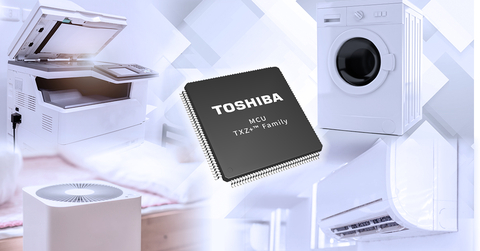Optimized for the main control of consumer and industrial equipment, and motor control
KAWASAKI, Japan — (BUSINESS WIRE) — April 25, 2022 — Toshiba Electronic Devices & Storage Corporation ("Toshiba") has started mass production of 21 new microcontrollers in the M3H group as new products in the TXZ+™ Family Advanced Class, manufactured in a 40nm process. The M3H group includes an ARM® Cortex®-M3 core running up to 120MHz, integrated max. 512KB code flash, and 32KB data flash memory with 100k write cycle endurance. These microcontrollers also offer various interface and motor control options, such as UART, I2C, Encoder, and Programmable Motor Control. M3H group devices are suited for a wide range of applications including motors, home appliances, and industrial equipment.
This press release features multimedia. View the full release here: https://www.businesswire.com/news/home/20220425005036/en/

Toshiba: New M3H Group of ARM(R) Cortex(R)-M3 Microcontrollers in the TXZ+(TM) Family Advanced Class (Graphic: Business Wire)
In response to the diversity of consumer equipment, the new M3H group products have enhanced communications functions integrated as UART, TSPI, I2C, and a 2-unit DMAC. Moreover, a digital LCD driver is integrated to reduce the number of components for display function, facilitate contrast adjustment, and ensure a flexible board layout.
These devices support a variety of sensing applications with a high-speed, high-precision 12-bit analog/digital converter (ADC) that allows individual sample and hold times to be set for each of the 21 ADC input channels. In addition, they provide a solution suitable for controlling AC motors and brushless DC motors in combination with an advanced programmable motor control circuit that can operate synchronously with the high-speed, high-precision 12-bit analog/digital converter.
The self-diagnosis functions incorporated in the devices for ROM, RAM, ADC and Clock help customers to achieve IEC60730 Class B functional safety certification.
Documentation, sample software with actual usage examples, and driver software that controls the interfaces for each peripheral can be downloaded from the Toshiba website. Evaluation boards and development environments are provided in cooperation with ARM global ecosystem partners.
Major features of new products
- High-performance ARM Cortex-M3 core, max 120MHz
- Optimized for consumer equipment with a wide range of memory and package lineup
- Self-diagnosis functions for IEC60730 class B functional safety
Applications
- For the main control of consumer equipment, home appliances, toys, office supply, health care equipment etc.,
- For the motor control of industrial equipment
Specifications
Product group |
||
CPU core |
ARM Cortex-M3
|
|
Max operation frequency |
120MHz |
|
Internal oscillator |
10MHz (+/-1%) |
|
Internal memory |
Flash (code) |
256KB/384KB/512KB
|
Flash (data) |
32KB (rewritable up to 100,000 times) |
|
RAM |
64KB (with Parity) and Backup RAM 2KB |
|
I/O port |
57 to 135 |
|
External interrupt |
12 to 23 |
|
DMA controller (DMAC) |
DMA requests: 2 units, 54 to 64 factors, internal/external triggers |
|
Timer function |
T32A |
32-bit Timer Event Counter
|
RTC |
Real-time Clock: 1 channel |
|
Communication function |
UART |
Universal Asynchronous Receiver Transmitter: 7 to 8 channels |
I2C |
I2C Interface: 2 to 4 channels |
|
TSPI |
Serial Peripheral Interface: 1 to 5 channels |
|
Analog function |
12-bit AD converter |
12 to 21 channels input |
8-bit Digital to Analog converter |
2 channels |
|
Motor control |
A-ENC |
Advanced Encoder Input Circuit: 1 channel |
A-PMD |
Advanced Programmable Motor Control Circuit: 1 channel |
|
| Other peripherals |
RMC |
Remote Control Signal Preprocessor: 1 channel |
| CRC |
CRC Calculation Circuit: 1 channel, CRC32, CRC16 |
|
| DLCD |
LCD Display Controller - Non-Bias Drive: 40 segments × 4 commons (Max) |
|
| System function |
SIWDT |
1 channel |
| LVD |
Voltage Detection Circuit: 1 channel |
|
| OFD |
Oscillation Frequency Detector: 1 channel |
|
| On-chip debug function |
Serial Wire / JTAG |
|
| Operation voltage |
2.7 to 5.5V, single voltage supply |
|
| Package / Pin |
LQFP144 (20mm x 20mm, 0.5mm pitch)
|
|








